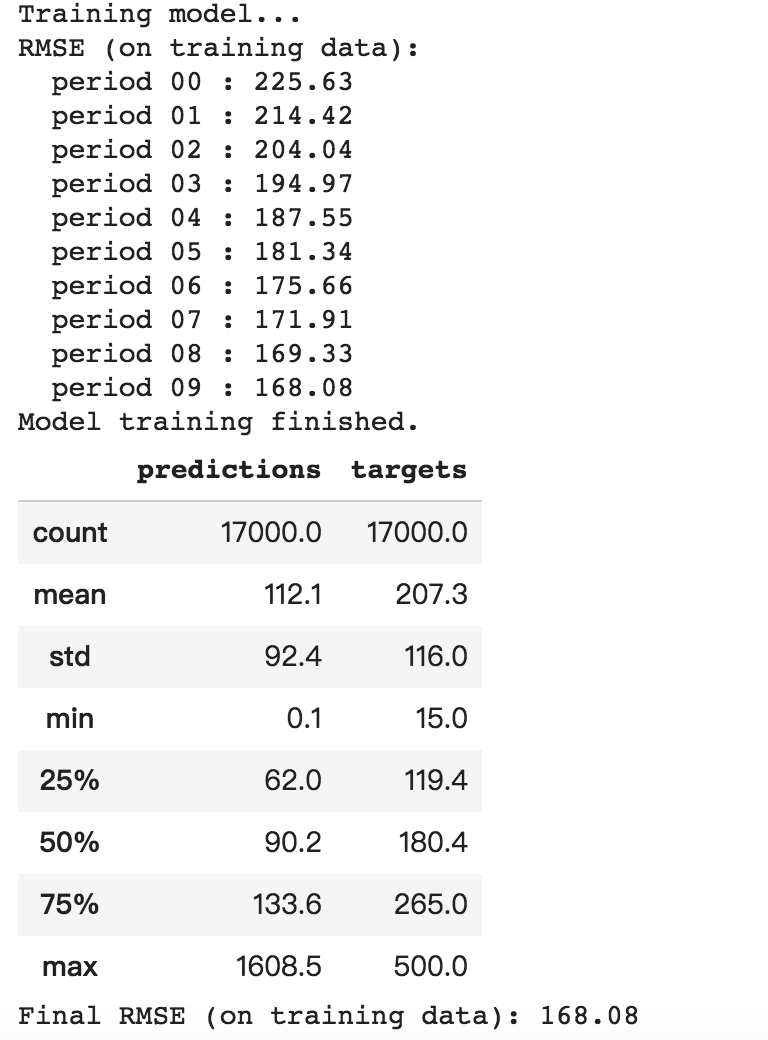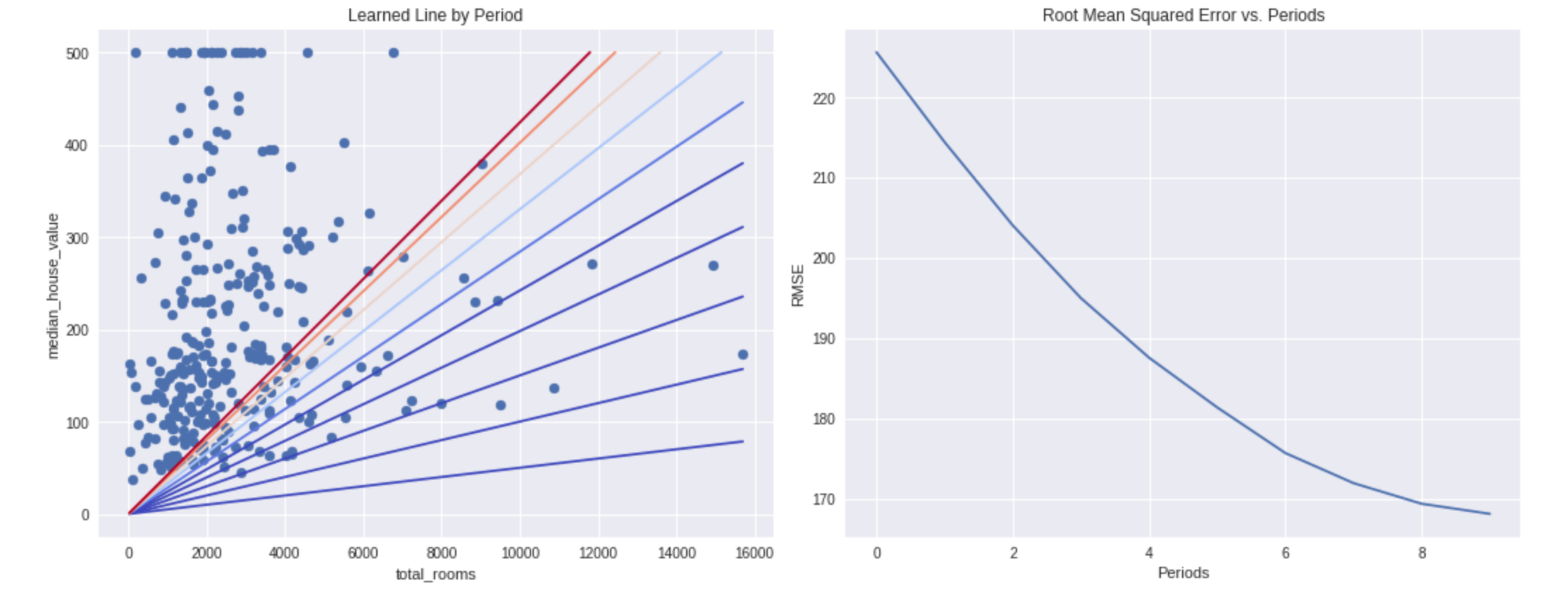tensorflow基础用法
标签:tensorflow基础目录
参考 https://developers.google.cn/machine-learning/crash-course/exercises
创建和操作张量
矢量加法
import tensorflow as tf
with tf.Graph().as_default():
# Create a six-element vector (1-D tensor).
primes = tf.constant([2, 3, 5, 7, 11, 13], dtype=tf.int32)
# Create another six-element vector. Each element in the vector will be
# initialized to 1. The first argument is the shape of the tensor (more
# on shapes below).
ones = tf.ones([6], dtype=tf.int32)
# Add the two vectors. The resulting tensor is a six-element vector.
just_beyond_primes = tf.add(primes, ones)
# Create a session to run the default graph.
with tf.Session() as sess:
print just_beyond_primes.eval()
#[ 3 4 6 8 12 14]
张量形状
with tf.Graph().as_default():
# A scalar (0-D tensor).
scalar = tf.zeros([])
# A vector with 3 elements.
vector = tf.zeros([3])
# A matrix with 2 rows and 3 columns.
matrix = tf.zeros([2, 3])
with tf.Session() as sess:
print 'scalar has shape', scalar.get_shape(), 'and value:\n', scalar.eval()
# 0.0
print 'vector has shape', vector.get_shape(), 'and value:\n', vector.eval()
# [0. 0. 0.]
print 'matrix has shape', matrix.get_shape(), 'and value:\n', matrix.eval()
#[[0. 0. 0.]
# [0. 0. 0.]]
广播
利用广播,元素级运算中的较小数组会增大到与较大数组具有相同的形状。
- 如果指令需要大小为
[6]的张量,则大小为[1]或[]的张量可以作为运算数。 - 如果指令需要大小为
[4, 6]的张量,则以下任何大小的张量都可以作为运算数。[1, 6][6][]
- 如果指令需要大小为
[3, 5, 6]的张量,则以下任何大小的张量都可以作为运算数。[1, 5, 6][3, 1, 6][3, 5, 1][1, 1, 1][5, 6][1, 6][6][1][]
当张量被广播时,从概念上来说,系统会复制其条目(出于性能考虑,实际并不复制。广播专为实现性能优化而设计)。
with tf.Graph().as_default():
# Create a six-element vector (1-D tensor).
primes = tf.constant([2, 3, 5, 7, 11, 13], dtype=tf.int32)
# Create a constant scalar with value 1.
ones = tf.constant(1, dtype=tf.int32)
# Add the two tensors. The resulting tensor is a six-element vector.
just_beyond_primes = tf.add(primes, ones)
with tf.Session() as sess:
print just_beyond_primes.eval()
矩阵乘法
with tf.Graph().as_default():
# Create a matrix (2-d tensor) with 3 rows and 4 columns.
x = tf.constant([[5, 2, 4, 3], [5, 1, 6, -2], [-1, 3, -1, -2]],
dtype=tf.int32)
# Create a matrix with 4 rows and 2 columns.
y = tf.constant([[2, 2], [3, 5], [4, 5], [1, 6]], dtype=tf.int32)
# Multiply `x` by `y`.
# The resulting matrix will have 3 rows and 2 columns.
matrix_multiply_result = tf.matmul(x, y)
with tf.Session() as sess:
print matrix_multiply_result.eval()
# [[35 58]
# [35 33]
# [ 1 -4]]
张量变形
with tf.Graph().as_default():
# Create an 8x2 matrix (2-D tensor).
matrix = tf.constant([[1,2], [3,4], [5,6], [7,8],
[9,10], [11,12], [13, 14], [15,16]], dtype=tf.int32)
# Reshape the 8x2 matrix into a 2x8 matrix.
reshaped_2x8_matrix = tf.reshape(matrix, (16,1))
# Reshape the 8x2 matrix into a 4x4 matrix
reshaped_4x4_matrix = tf.reshape(matrix, [4,4])
with tf.Session() as sess:
print "Original matrix (8x2):"
print matrix.eval()
print "Reshaped matrix (2x8):"
print reshaped_2x8_matrix.eval()
print "Reshaped matrix (4x4):"
print reshaped_4x4_matrix.eval()
with tf.Graph().as_default():
# Create an 8x2 matrix (2-D tensor).
matrix = tf.constant([[1,2], [3,4], [5,6], [7,8],
[9,10], [11,12], [13, 14], [15,16]], dtype=tf.int32)
# Reshape the 8x2 matrix into a 3-D 2x2x4 tensor.
reshaped_2x2x4_tensor = tf.reshape(matrix, [2,2,4])
# Reshape the 8x2 matrix into a 1-D 16-element tensor.
one_dimensional_vector = tf.reshape(matrix, [16])
with tf.Session() as sess:
print "Original matrix (8x2):"
print matrix.eval()
print "Reshaped 3-D tensor (2x2x4):"
print reshaped_2x2x4_tensor.eval()
print "1-D vector:"
print one_dimensional_vector.eval()
变量、初始化和赋值
创建变量时,可以明确设置一个初始值,也可以使用初始化程序(例如分布):
g = tf.Graph()
with g.as_default():
# Create a variable with the initial value 3.
v = tf.Variable([3])
# Create a variable of shape [1], with a random initial value,
# sampled from a normal distribution with mean 1 and standard deviation 0.35.
w = tf.Variable(tf.random_normal([1], mean=1.0, stddev=0.35))
TensorFlow 的一个特性是变量初始化不是自动进行的。例如,以下代码块会导致错误:
with g.as_default():
with tf.Session() as sess:
try:
v.eval()
except tf.errors.FailedPreconditionError as e:
print "Caught expected error: ", e
# Caught expected error: Attempting to use uninitialized value Variable
#[[Node: _retval_Variable_0_0 = _Retval[T=DT_INT32, index=0, _device="/job:localhost/replica:0/task:0/device:CPU:0"](Variable)]]
最简单的方法,是调用global_variables_initializer,初始化后,变量的值保留在同一会话中(不过,当启动新会话时,需要重新初始化)
with g.as_default():
with tf.Session() as sess:
initialization = tf.global_variables_initializer()
sess.run(initialization)
# Now, variables can be accessed normally, and have values assigned to them.
print v.eval()
print w.eval()
要更改变量的值,使用assign指令。请注意,仅创建 assign 指令不会起到任何作用。和初始化一样,必须运行赋值指令才能更新变量值:
with g.as_default():
with tf.Session() as sess:
sess.run(tf.global_variables_initializer())
# This should print the variable's initial value.
print v.eval()
assignment = tf.assign(v, [7])
# The variable has not been changed yet!
print v.eval()
# Execute the assignment op.
sess.run(assignment)
# Now the variable is updated.
print v.eval()
练习:
创建一个骰子模拟,在模拟中生成一个 10x3 二维张量,其中:
- 列
1和2均存储一个骰子的一次投掷值。 - 列
3存储同一行中列1和2的值的总和。
例如,第一行中可能会包含以下值:
- 列
1存储4 - 列
2存储3 - 列
3存储7
with tf.Graph().as_default(), tf.Session() as sess:
# Task 2: Simulate 10 throws of two dice. Store the results
# in a 10x3 matrix.
# We're going to place dice throws inside two separate
# 10x1 matrices. We could have placed dice throws inside
# a single 10x2 matrix, but adding different columns of
# the same matrix is tricky. We also could have placed
# dice throws inside two 1-D tensors (vectors); doing so
# would require transposing the result.
dice1 = tf.Variable(tf.random_uniform([10, 1],
minval=1, maxval=7,
dtype=tf.int32))
dice2 = tf.Variable(tf.random_uniform([10, 1],
minval=1, maxval=7,
dtype=tf.int32))
# We may add dice1 and dice2 since they share the same shape
# and size.
dice_sum = tf.add(dice1, dice2)
# We've got three separate 10x1 matrices. To produce a single
# 10x3 matrix, we'll concatenate them along dimension 1.
resulting_matrix = tf.concat(
values=[dice1, dice2, dice_sum], axis=1)
# The variables haven't been initialized within the graph yet,
# so let's remedy that.
sess.run(tf.global_variables_initializer())
print(resulting_matrix.eval())
pandas
pandas官网:http://pandas.pydata.org/pandas-docs/stable/index.html
基本概念
pandas 中的主要数据结构被实现为以下两类:
DataFrame,您可以将它想象成一个关系型数据表格,其中包含多个行和已命名的列。Series,它是单一列。DataFrame中包含一个或多个Series,每个Series均有一个名称。
import pandas as pd
例如:
city_names = pd.Series(['San Francisco', 'San Jose', 'Sacramento'])
population = pd.Series([852469, 1015785, 485199])
pd.DataFrame({ 'City name': city_names, 'Population': population })
加载整个文件,并显示一些统计信息(如:count/mean/std/min/25%/50%/75%/max):
california_housing_dataframe = pd.read_csv("https://storage.googleapis.com/mledu-datasets/california_housing_train.csv", sep=",")
california_housing_dataframe.describe()
显示前几条记录:
california_housing_dataframe.head()
绘制图表(某一列的值的分布):
california_housing_dataframe.hist('housing_median_age')
访问数据
cities = pd.DataFrame({ 'City name': city_names, 'Population': population })
cities['City name'] # 直接访问某一列
cities['City name'][1] # 访问某一列的某一行
cities[0:2] # 整个表格的第0-1行的所有列的数据
pandas的索引和选择官方文档
操控数据
可以直接进行算术运算:
population / 1000.
也可以通过numpy的函数进行操作
import numpy as np
np.log(population)
也可以通过apply以及lambda进行操作:
population.apply(lambda val: val > 1000000)
dataframe的修改,可以直接操作:
cities['Area square miles'] = pd.Series([46.87, 176.53, 97.92])
cities['Population density'] = cities['Population'] / cities['Area square miles']
cities['Is wide and has saint name'] = (cities['Area square miles'] > 50) & cities['City name'].apply(lambda name: name.startswith('San'))
索引
Series 和 DataFrame 对象也定义了 index 属性,该属性会向每个 Series 项或 DataFrame 行赋一个标识符值。
默认情况下,在构造时,pandas 会赋可反映源数据顺序的索引值。索引值在创建后是稳定的;也就是说,它们不会因为数据重新排序而发生改变。
city_names.index # RangeIndex(start=0, stop=3, step=1),city_names这一列有0,1,2总共3行
cities.index # RangeIndex(start=0, stop=3, step=1),整个dataframe有0,1,2总共3行
调用 DataFrame.reindex 以手动重新排列各行的顺序。
cities.reindex([2, 0, 1])
#City name Population Area square miles Population density Is wide and has saint name
#2 Sacramento 485199 97.92 4955.055147 False
#0 San Francisco 852469 46.87 18187.945381 False
#1 San Jose 1015785 176.53 5754.177760 True
重建索引是一种随机排列 DataFrame 的绝佳方式。(参考https://blog.csdn.net/you_are_my_dream/article/details/70165384,np.random.permutation与np.random.shuffle有两处不同: 如果传给permutation一个矩阵,它会返回一个洗牌后的矩阵副本;而shuffle只是对一个矩阵进行洗牌,无返回值。 如果传入一个整数,它会返回一个洗牌后的arange。)
cities.reindex(np.random.permutation(cities.index))
注意: 如果您的 reindex 输入数组包含原始 DataFrame 索引值中没有的值,reindex 会为此类“丢失的”索引添加新行,并在所有对应列中填充 NaN 值:
cities.reindex([0, 4, 5, 2])
# City name Population Area square miles Population density Is wide and has saint name
#0 San Francisco 852469.0 46.87 18187.945381 False
#4 NaN NaN NaN NaN NaN
#5 NaN NaN NaN NaN NaN
#2 Sacramento 485199.0 97.92 4955.055147 False
线性回归
定义特征并配置特征列
在 TensorFlow 中,我们使用一种称为“特征列”的结构来表示特征的数据类型。特征列仅存储对特征数据的描述;不包含特征数据本身。
主要有两类数据:
- 分类数据:一种文字数据。
- 数值数据:一种数字(整数或浮点数)数据以及您希望视为数字的数据。有时您可能会希望将数值数据(例如邮政编码)视为分类数据。
# Define the input feature: total_rooms.
my_feature = california_housing_dataframe[["total_rooms"]]
# Configure a numeric feature column for total_rooms.
feature_columns = [tf.feature_column.numeric_column("total_rooms")]
定义目标:
targets = california_housing_dataframe["median_house_value"]
配置 LinearRegressor
使用```clip_gradients_by_norm``将梯度裁剪应用到我们的优化器。梯度裁剪可确保梯度大小在训练期间不会变得过大,梯度过大会导致梯度下降法失败。
# Use gradient descent as the optimizer for training the model.
my_optimizer = tf.train.GradientDescentOptimizer(learning_rate=0.0000001)
my_optimizer = tf.contrib.estimator.clip_gradients_by_norm(my_optimizer, 5.0)
# Configure the linear regression model with our feature columns and optimizer.
# Set a learning rate of 0.0000001 for Gradient Descent.
linear_regressor = tf.estimator.LinearRegressor(
feature_columns=feature_columns,
optimizer=my_optimizer
)
定义输入函数
将 Pandas 特征数据转换成 NumPy 数组字典,例如,本例中就是把pandas的一列”total_rooms”:[3.,20.,…,42.]变成一个字典{“total_rooms”:array([3.,20.,…42.])}
使用 TensorFlow Dataset API 根据我们的数据构建 Dataset 对象,并将数据拆分成大小为 batch_size 的多批数据,以按照指定周期数 (num_epochs) 进行重复。
如果 shuffle 设置为 True,则我们会对数据进行随机处理,以便数据在训练期间以随机方式传递到模型。buffer_size 参数会指定 shuffle 将从中随机抽样的数据集的大小(representing the number of elements from this dataset from which the new dataset will sample)。
def my_input_fn(features, targets, batch_size=1, shuffle=True, num_epochs=None):
"""Trains a linear regression model of one feature.
Args:
features: pandas DataFrame of features
targets: pandas DataFrame of targets
batch_size: Size of batches to be passed to the model
shuffle: True or False. Whether to shuffle the data.
num_epochs: Number of epochs for which data should be repeated. None = repeat indefinitely
Returns:
Tuple of (features, labels) for next data batch
"""
# Convert pandas data into a dict of np arrays.
features = {key:np.array(value) for key,value in dict(features).items()}
# Construct a dataset, and configure batching/repeating
ds = Dataset.from_tensor_slices((features,targets)) # warning: 2GB limit
ds = ds.batch(batch_size).repeat(num_epochs)
# Shuffle the data, if specified
if shuffle:
ds = ds.shuffle(buffer_size=10000)
# Return the next batch of data
features, labels = ds.make_one_shot_iterator().get_next()
return features, labels
训练模型
_ = linear_regressor.train(
input_fn = lambda:my_input_fn(my_feature, targets),
steps=100
)
评估模型
# Create an input function for predictions.
# Note: Since we're making just one prediction for each example, we don't
# need to repeat or shuffle the data here.
prediction_input_fn =lambda: my_input_fn(my_feature, targets, num_epochs=1, shuffle=False)
# Call predict() on the linear_regressor to make predictions.
predictions = linear_regressor.predict(input_fn=prediction_input_fn)
# Format predictions as a NumPy array, so we can calculate error metrics.
predictions = np.array([item['predictions'][0] for item in predictions])
# Print Mean Squared Error and Root Mean Squared Error.
mean_squared_error = metrics.mean_squared_error(predictions, targets)
root_mean_squared_error = math.sqrt(mean_squared_error)
print "Mean Squared Error (on training data): %0.3f" % mean_squared_error
print "Root Mean Squared Error (on training data): %0.3f" % root_mean_squared_error
RMSE 的一个很好的特性是,它可以在与原目标相同的规模下解读。
min_house_value = california_housing_dataframe["median_house_value"].min()
max_house_value = california_housing_dataframe["median_house_value"].max()
min_max_difference = max_house_value - min_house_value
print "Min. Median House Value: %0.3f" % min_house_value
print "Max. Median House Value: %0.3f" % max_house_value
print "Difference between Min. and Max.: %0.3f" % min_max_difference
print "Root Mean Squared Error: %0.3f" % root_mean_squared_error
可以通过以下方法获得均匀分布的随机数据样本:
sample = california_housing_dataframe.sample(n=300)
重新训练
在 10 个等分的时间段内使用此函数,以便观察模型在每个时间段的改善情况。
对于每个时间段,我们都会计算训练损失并绘制相应图表。这可以帮助您判断模型收敛的时间,或者模型是否需要更多迭代。
此外,我们还会绘制模型随着时间的推移学习的特征权重和偏差项值的曲线图。您还可以通过这种方式查看模型的收敛效果。
def train_model(learning_rate, steps, batch_size, input_feature="total_rooms"):
"""Trains a linear regression model of one feature.
Args:
learning_rate: A `float`, the learning rate.
steps: A non-zero `int`, the total number of training steps. A training step
consists of a forward and backward pass using a single batch.
batch_size: A non-zero `int`, the batch size.
input_feature: A `string` specifying a column from `california_housing_dataframe`
to use as input feature.
"""
periods = 10
steps_per_period = steps / periods
my_feature = input_feature
my_feature_data = california_housing_dataframe[[my_feature]]
my_label = "median_house_value"
targets = california_housing_dataframe[my_label]
# Create feature columns
feature_columns = [tf.feature_column.numeric_column(my_feature)]
# Create input functions
training_input_fn = lambda:my_input_fn(my_feature_data, targets, batch_size=batch_size)
prediction_input_fn = lambda: my_input_fn(my_feature_data, targets, num_epochs=1, shuffle=False)
# Create a linear regressor object.
my_optimizer = tf.train.GradientDescentOptimizer(learning_rate=learning_rate)
my_optimizer = tf.contrib.estimator.clip_gradients_by_norm(my_optimizer, 5.0)
linear_regressor = tf.estimator.LinearRegressor(
feature_columns=feature_columns,
optimizer=my_optimizer
)
# Set up to plot the state of our model's line each period.
plt.figure(figsize=(15, 6))
plt.subplot(1, 2, 1)
plt.title("Learned Line by Period")
plt.ylabel(my_label)
plt.xlabel(my_feature)
sample = california_housing_dataframe.sample(n=300)
plt.scatter(sample[my_feature], sample[my_label])
colors = [cm.coolwarm(x) for x in np.linspace(-1, 1, periods)]
# Train the model, but do so inside a loop so that we can periodically assess
# loss metrics.
print "Training model..."
print "RMSE (on training data):"
root_mean_squared_errors = []
for period in range (0, periods):
# Train the model, starting from the prior state.
linear_regressor.train(
input_fn=training_input_fn,
steps=steps_per_period
)
# Take a break and compute predictions.
predictions = linear_regressor.predict(input_fn=prediction_input_fn)
predictions = np.array([item['predictions'][0] for item in predictions])
# Compute loss.
root_mean_squared_error = math.sqrt(
metrics.mean_squared_error(predictions, targets))
# Occasionally print the current loss.
print " period %02d : %0.2f" % (period, root_mean_squared_error)
# Add the loss metrics from this period to our list.
root_mean_squared_errors.append(root_mean_squared_error)
# Finally, track the weights and biases over time.
# Apply some math to ensure that the data and line are plotted neatly.
y_extents = np.array([0, sample[my_label].max()])
weight = linear_regressor.get_variable_value('linear/linear_model/%s/weights' % input_feature)[0]
bias = linear_regressor.get_variable_value('linear/linear_model/bias_weights')
x_extents = (y_extents - bias) / weight
x_extents = np.maximum(np.minimum(x_extents,
sample[my_feature].max()),
sample[my_feature].min())
y_extents = weight * x_extents + bias
plt.plot(x_extents, y_extents, color=colors[period])
print "Model training finished."
# Output a graph of loss metrics over periods.
plt.subplot(1, 2, 2)
plt.ylabel('RMSE')
plt.xlabel('Periods')
plt.title("Root Mean Squared Error vs. Periods")
plt.tight_layout()
plt.plot(root_mean_squared_errors)
# Output a table with calibration data.
calibration_data = pd.DataFrame()
calibration_data["predictions"] = pd.Series(predictions)
calibration_data["targets"] = pd.Series(targets)
display.display(calibration_data.describe())
print "Final RMSE (on training data): %0.2f" % root_mean_squared_error
train_model(
learning_rate=0.00002,
steps=500,
batch_size=5
)


原创文章,转载请注明出处!
本文链接:http://daiwk.github.io/posts/platform-tf-basics.html